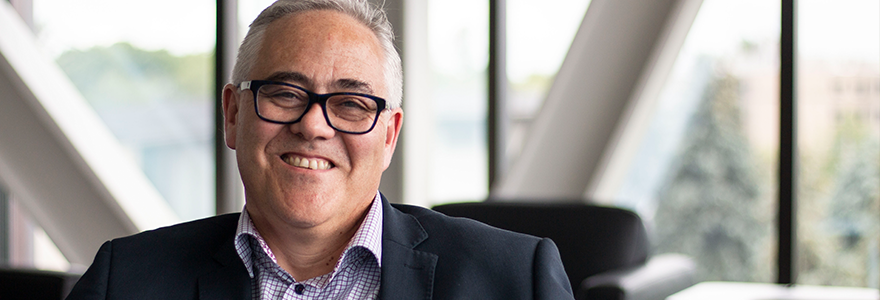Media
Contact
Communications Specialist
Faculty of Engineering
Spencer Engineering Building
Room 2072
Western University
Tel: 519-661-2111 ext. 87015
Email: engineeringcomms@uwo.ca
Q&A with Dean Ken Coley

Western Engineering News | September 9, 2019
Effective July 1, 2019, nationally renowned researcher, educator and administrator Ken Coley became Dean of Western Engineering. Ken is an outstanding academic leader who brings with him a wealth of innovative ideas about teaching, research and recruitment.
As Ken settles into his new role, we sat down with him to learn more about his career, his vision for the faculty, and the opportunities and challenges he’s most excited to take on here at Western Engineering.
Tell us about the career path that led you to Western.
Immediately after my PhD, I started working at the National Physical Laboratory in the UK. I had thought about the possibility of an academic career, but I decided it wasn’t what I was looking for. Out of the blue, an opportunity came up at the University of Strathclyde, which is in my home town of Glasgow, Scotland. That set me down the academic road, although, as it turns out, that particular road had a turn or two I wasn’t expecting at the time.
After seven years at Strathclyde, McMaster University contacted me about a position that seemed perfect for me. I visited McMaster, and, if I hadn’t been sold on the job already, I certainly was then. Long story short, I ended up shipping my family across the Atlantic, where I started a 23-year career at McMaster. I hadn’t expected to become involved in academic leadership, but successive deans kept opening doors for me and I became involved in a variety of leadership opportunities.
I was extremely lucky; all successful academic leaders will tell you that their success is a team effort and my good fortune has been to work with outstanding teams. McMaster was a great experience from start to finish and really helped me to develop in my various roles. That ultimately brought me to Western – again, something I wasn’t expecting, but I somewhat tentatively threw my hat in the ring.
I became more and more impressed with Western Engineering as the process moved along. By the time it came down to making the decision, it was a very easy choice and would have been very tough not to have come here. My first few weeks in the job have convinced me that I was right.
What is your vision for Western Engineering over the next few years?
The vision needs to be a shared vision, and I can’t develop a shared vision on my own. I’m in the process of having a lot of conversations, and until I’ve had these conversations, I don’t have a clear enough understanding of what the faculty wants. My No. 1 priority for the short term is to get to know the faculty, staff and students, both collectively and individually, before I address other priorities.
There are clearly areas of enormous strength at Western Engineering, and there are clearly some outstanding researchers and educational programs. It’ll come down to looking for opportunities to leverage existing strengths into transformative initiatives as well as finding the areas where we can do a little bit better.
I ‘d like to see us make a better connection between undergraduate education and research by providing a lot more undergraduate students with the opportunities to work in professors’ labs.
I’d also like to build on the strength that Western Engineering has with dual degree programs and create more flexibility and increase opportunities for self-customization of programming within engineering.
Where do you feel the biggest challenges lie for Western Engineering?
I think the problem is going to be – as is probably true for every engineering school in Canada at the moment – we may not have the resources to do everything we want to. We need to prioritize very carefully. But it also means we have to look at ways of expanding our income stream.
The purpose of universities is not to make money, but to serve their community, educate students and produce high-quality research. To my mind, we’re doing that, but we can do more of it and we can do it better. We need to find a way to finance it.
What opportunities are you most enthusiastic to take on here at Western Engineering?
I mentioned already that we have some extremely strong researchers. I would like to resource our best, but also find ways to bring our more junior researchers up to the level of our best. This will require resources and, to my mind, a big part of the Dean’s job is to find these resources.
I’m also excited to build on the opportunities we’ve already structured into our curriculum, but I want to enhance the experiential elements to a much greater extent and make a strong link between the in-class work and experiences outside of the classroom.
What are some of your proudest moments as a leader?
I’m most proud of my time as Associate Dean at McMaster, where we were able to bring our first- to second-year attrition rate down from 22% to about 4%.
On the programming side, I feel very proud of the program structure we developed for the Integrated Biomedical Engineering and Health Sciences Program. I was especially proud of it because it was a collaboration with another faculty, and we developed what I think is quite an innovative program structure that has acted as a template for major change in the entire McMaster Engineering curriculum.
I am proud of many things I achieved at McMaster and will always be grateful for the opportunities I was given, but now I am opening a new chapter in my career, and I am excited at the wonderful new opportunity Western has granted me.

